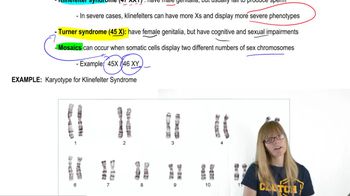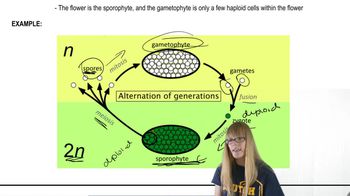If the haploid number for a plant species is 4, how many chromosomes are found in a member of the species that has one of the following characteristics? Explain your reasoning in each case.
diploidy
Table of contents
- 1. Introduction to Genetics51m
- 2. Mendel's Laws of Inheritance3h 37m
- 3. Extensions to Mendelian Inheritance2h 41m
- 4. Genetic Mapping and Linkage2h 28m
- 5. Genetics of Bacteria and Viruses1h 21m
- 6. Chromosomal Variation1h 48m
- 7. DNA and Chromosome Structure56m
- 8. DNA Replication1h 10m
- 9. Mitosis and Meiosis1h 34m
- 10. Transcription1h 0m
- 11. Translation58m
- 12. Gene Regulation in Prokaryotes1h 19m
- 13. Gene Regulation in Eukaryotes44m
- 14. Genetic Control of Development44m
- 15. Genomes and Genomics1h 50m
- 16. Transposable Elements47m
- 17. Mutation, Repair, and Recombination1h 6m
- 18. Molecular Genetic Tools19m
- 19. Cancer Genetics29m
- 20. Quantitative Genetics1h 26m
- 21. Population Genetics50m
- 22. Evolutionary Genetics29m
6. Chromosomal Variation
Chromosomal Mutations: Aberrant Euploidy
Problem 9
Textbook Question
Mating between a male donkey (2n=62) and a female horse (2n=64) produces sterile mules. Recently, however, a very rare event occurred—a female mule gave birth to an offspring by mating with a horse.
Determine how many chromosomes are in the mule karyotype, and explain why mules are generally sterile.
 Verified step by step guidance
Verified step by step guidance1
Step 1: Determine the chromosome number of the mule. A mule is the hybrid offspring of a male donkey (2n=62) and a female horse (2n=64). To calculate the mule's chromosome number, add half the chromosome count from each parent: (62/2) + (64/2). This gives the mule's diploid chromosome number.
Step 2: Explain why mules are generally sterile. Mules inherit one set of chromosomes from the donkey and one set from the horse. These two sets of chromosomes are not homologous, meaning they cannot pair properly during meiosis. This failure to form homologous pairs prevents the production of viable gametes, leading to sterility.
Step 3: Discuss the rare case of a female mule giving birth. In rare instances, a mule may produce offspring if a viable egg is formed. This could occur if the mule's chromosomes undergo an unusual alignment or if the egg is formed through a process that bypasses normal meiosis.
Step 4: Analyze the offspring's chromosome number. If the female mule mates with a horse (2n=64), the offspring's chromosome number would depend on the mule's gamete and the horse's gamete. The mule's gamete would likely contribute half of its chromosome count, and the horse's gamete would contribute half of its chromosome count.
Step 5: Summarize the genetic implications. The sterility of mules highlights the importance of homologous chromosome pairing in meiosis. This case also demonstrates how rare genetic events can lead to exceptions in hybrid sterility, providing insights into reproductive barriers and hybridization.
 Verified video answer for a similar problem:
Verified video answer for a similar problem:This video solution was recommended by our tutors as helpful for the problem above
Video duration:
1mPlay a video:
Was this helpful?
Key Concepts
Here are the essential concepts you must grasp in order to answer the question correctly.
Chromosome Number and Karyotype
A karyotype is a visual representation of an organism's complete set of chromosomes, organized by size and shape. In this case, the male donkey has 62 chromosomes (2n=62) and the female horse has 64 chromosomes (2n=64). Mules, which are hybrids of these two species, typically have 63 chromosomes (2n=63), resulting from the combination of one set from each parent.
Recommended video:
Guided course

Human Sex Chromosomes
Hybrid Sterility
Hybrid sterility occurs when the offspring of two different species are unable to reproduce. In the case of mules, they are sterile because they have an odd number of chromosomes (63), which complicates meiosis—the process of forming gametes. During meiosis, the chromosomes cannot pair properly, leading to the production of nonviable gametes.
Recommended video:
Guided course

Drosophila P Element
Meiosis and Gamete Formation
Meiosis is a specialized type of cell division that reduces the chromosome number by half, producing gametes (sperm and eggs). In sexually reproducing organisms, proper pairing and segregation of homologous chromosomes are crucial for viable gamete formation. In mules, the lack of homologous pairs due to the odd chromosome number disrupts this process, resulting in infertility.
Recommended video:
Guided course

Formation of Plant Gametes
Related Videos
Related Practice
Textbook Question
367
views


